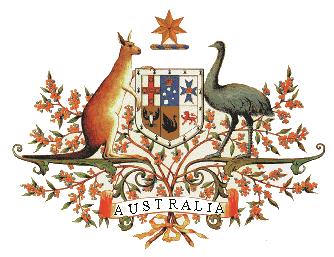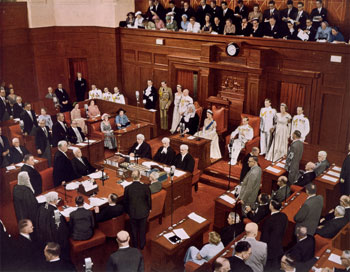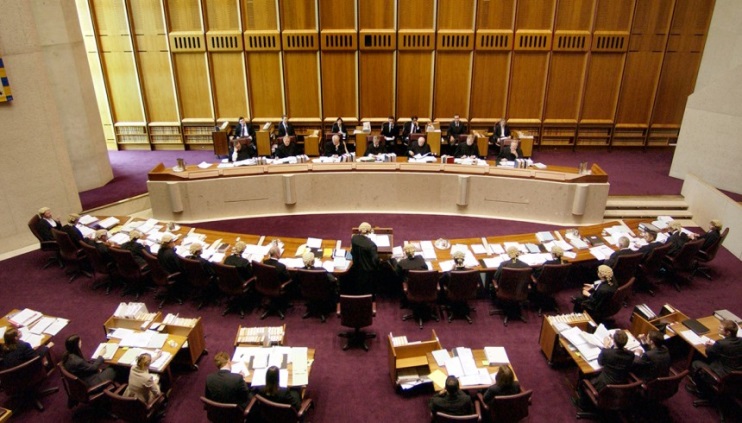Australia is a federation of six states which, together with two self-governing territories, have their own constitutions, parliaments, governments and laws. This infosheet is about the national or central government, usually called the Federal Government, Commonwealth Government or Australian Government. However, state and territory governments are also based on the same principle of parliamentary government.
It is recommended that this infosheet be read with Infosheet No. 13 The Constitution and Infosheet No. 19 The House, government and opposition.

The Australian Coat of Arms signifies the national unity of Australia and is a sign of its identity and authority
Parliamentary government
The Constitution of Australia establishes the Federal Government by providing for the Parliament, the Executive Government and the Judicature (more usually called the Judiciary)—sometimes referred to as the ‘three arms of government’. However, some of the central features of Australia’s system of government (described as parliamentary, or responsible government) are not set down in the Constitution but are based on custom and convention.
Parliamentary government means that the Executive Government comes from within the Parliament; responsible government means that the Executive Government is responsible to the Parliament. This is the central feature of a Westminster-style government following the United Kingdom model—in contrast to other systems of government where the Executive is quite separate and not directly answerable to the Legislature—for example, in the United States of America.
The separation of powers
Political theory recognises three powers of government—the legislative power to make laws; the executive power to carry out and enforce the laws; and the judicial power to interpret laws and to judge whether they apply in individual cases.
The principle of the separation of powers is that, in order to prevent oppressive government, the three powers of government should be held by separate bodies—the Legislature, Executive and Judiciary—which can act as checks and balances on each other.
With parliamentary government the legislative and executive functions overlap, as the members of the Executive Government—the Ministers—are drawn from the Parliament. However, in the Australian system there are still checks and balances between the Executive and Legislature—Ministers are subject to the scrutiny of other Members of the Parliament led by an officially recognised opposition. In addition, the Executive does not necessarily control both Houses of the Parliament (see below).
Infosheet No. 19 The House, government and opposition gives more detail on the relationship between the Parliament and the Executive Government.
The Parliament
The Constitution gives the legislative power of the Commonwealth—the power to make laws—to the Parliament.
The Parliament consists of the King, represented by the Governor-General, and two Houses—the House of Representatives and the Senate. The Parliament passes legislation. Proposed laws have to be agreed to by both Houses of Parliament to become law. The two Houses have equal powers, except that there are restrictions on the power of the Senate to introduce or directly amend some kinds of financial legislation. Infosheet No. 7 Making laws describes the parliamentary processes for the passage of legislation. The Governor-General has a role in the legislative process by assenting to Acts. See later in this infosheet for more information about the role of the Governor-General.
The Parliament also authorises the Executive Government (often simply called the government or the Executive) to spend public money by agreeing to government proposals for expenditure and taxation, scrutinises the administrative actions of the government and serves as a forum for the debate of public policy.
Another function of the Parliament under the Australian system is to provide from its membership the members of the Executive Government. After a general election the political party (or coalition of parties) with the support of a majority of members in the House of Representatives becomes the governing party and its leader becomes the Prime Minister.
The composition of the House also determines who will form the official opposition. The party (or coalition of parties) which has the most non-government Members in the House of Representatives becomes the opposition party and its leader becomes the Leader of the Opposition. The opposition has the officially recognised function, established by convention, of opposing the government. The opposition is an essential part of Australia’s democratic system of government. This subject is discussed in more detail in Infosheet No. 19 The House, government and opposition.
While the government has, by definition, the support of a majority of Members in the House of Representatives, the system of voting used for Senate elections gives greater opportunity to minority parties and independents, and the government often does not have majority support in the Senate.
The Executive Government
Constitutional provisions
The Constitution states that the executive power of the Commonwealth is vested in the Queen1 and is exercisable by the Governor-General as the Queen’s representative. However, a realistic understanding of Australia’s Executive Government cannot be obtained from the Constitution alone, and in fact a literal reading of the Constitution can be misleading.
The Executive Government in practice
In reality, the executive power is possessed by the Prime Minister and Cabinet (senior Ministers). Their power derives:
- constitutionally from their membership of the Federal Executive Council—see below—and status as ‘advisers’ to the Governor-General
- politically, from the people at elections for the House of Representatives
- from convention—that is, custom and tradition.
Neither the Prime Minister nor the Cabinet are mentioned in the Constitution—the framers of the Constitution took their existence for granted, as they did the various conventions of the Westminster system of government inherited from the United Kingdom.
Table 1 below gives a comparison of the constitutional provisions and the actual practice according to the conventions which have operated in Australia.
Composition of the Ministry
Prime Minister
The Prime Minister is the head of the government. They achieve this position by being the elected leader of the party in government (in the case of a coalition government, the major party).
Cabinet
The Cabinet, consisting of senior Ministers presided over by the Prime Minister, is the government’s pre-eminent policy-making body. Major policy and legislative proposals are decided by the Cabinet. The Prime Minister selects Ministers for Cabinet positions.
Ministers
Ministers are selected by the Prime Minister. Legislation currently allows for up to 30 Ministers. About 20 or so senior Ministers administer the major departments and are, usually, members of Cabinet. Other Ministers are responsible for particular areas of administration within a major department, or may be in charge of a small department. Ministers are appointed from both Houses of Parliament, although most (about two thirds) are Members of the House of Representatives.
Parliamentary Secretaries
Up to 12 Members and Senators are appointed by the Prime Minister as Parliamentary Secretaries (also referred to as Assistant Ministers) to assist or represent Ministers in their administrative responsibilities.
The role of the Governor-General
The Governor-General performs the ceremonial functions of head of state on behalf of the Queen. While Executive Government powers are exercised by the Governor-General or in the Governor-General’s name, such actions are carried out as advised by the Prime Minister and Ministers.
Under the Constitution the Governor-General:
- appoints and dismisses Executive Councillors
- appoints and dismisses Ministers to administer the public service departments and agencies
- appoints judges (the dismissal of judges can only be initiated by the Parliament)
- is the commander in chief of the defence forces
- decides when the Parliament meets (subject to some constitutional requirements), and may prorogue (suspend) or dissolve it
- issues writs for general elections
- initiates government expenditure by recommending appropriations to the Parliament
- converts proposed laws to Acts of Parliament by assenting to legislation that has been passed by both Houses
- may block or propose amendments to any law passed by the two Houses of Parliament.
The Governor-General also has executive powers under many Acts of Parliament—for example, the power to proclaim legislation (that is, bring it into effect) and to make regulations and other kinds of delegated legislation (that is, legislative powers that the Parliament has delegated to the Executive Government). Most of the executive actions taken by the Governor-General are of this kind.
In practice, except when reserve powers are involved—see below—these functions are exercised as advised by the Prime Minister and Ministers.
The Governor-General’s reserve powers
In some matters the Constitution gives the Governor-General powers to act independently. These include the power to dissolve the House of Representatives and, in certain situations, both Houses (see Infosheet No. 18 Double dissolution). However, in other than exceptional circumstances, the Governor-General will follow the advice of a Prime Minister who retains the confidence of the House.
The powers that the Governor-General has to act without advice are referred to as ‘prerogative’ or ‘reserve’ powers and are not clearly defined in the Constitution. Constitutional experts do not agree on their precise extent or on the nature of the exceptional circumstances in which they may be exercised.
The Federal Executive Council
The Federal Executive Council is the constitutional mechanism for providing ministerial advice to the Governor-General. It is not a forum for policy debate or deliberation and its proceedings are entirely formal. All Ministers and Parliamentary Secretaries become members of the Executive Council. They receive the title ‘Honourable’. The Council’s full membership never meets. In practice the minimum number of Ministers or Parliamentary Secretaries (that is, two in addition to the person presiding) are rostered to attend. Meetings of the Council are presided over by the Governor-General or a deputy appointed by the Governor-General (usually the Minister with the title Vice President of the Executive Council). The matters dealt with at each meeting are recommendations by Ministers, for the approval of the Governor-General in Council, that something be done—for example, that a regulation be made, a treaty be ratified, or a person be appointed to a position.
While the Executive Council may seem no more than a rubber stamp, the processes involved in bringing matters before the Council ensure that Ministers’ actions are properly documented, are legally and constitutionally valid, and are in accordance with government policy.

Opening of the 3rd Session of the 20th Parliament by Her Majesty Queen Elizabeth II on 15 February 1954
The role of the King
Australia is a constitutional monarchy. A monarchy is a country where the position of head of state is inherited. A constitutional monarchy is one where the powers of the monarch or sovereign—the King or Queen—are limited by law or convention, and generally exercised only according to the advice of an elected government.
The head of state is a formal, symbolic and ceremonial position, as opposed to the position of head of government, which has the administrative power to govern the country. In some systems of government the head of state and head of government are the same person—for example, in the United States the President has both functions.
Australia’s head of state is King Charles III. King Charles is also King of the United Kingdom and several other countries which used to be part of the former British Empire. The King's role as King of Australia is quite separate from his role as King of the United Kingdom. The United Kingdom Government plays no part in the King’s role as King of Australia.
In Australia the powers of the King have been delegated by the Australian Constitution to his representative in Australia, the Governor-General. That is, while Australia’s head of state is the King, the functions of head of state are performed by the Governor-General. The King’s only necessary constitutional function is to appoint the Governor-General, and in doing this the King acts as advised by the Australian Prime Minister. The Constitution gives the King the power to disallow an Australian Act of Parliament, but this has never been done and it is extremely unlikely that it would ever be done.
The Judiciary
The Constitution vests the judicial power of the Commonwealth—the power to interpret laws and to judge whether they apply in individual cases—in the High Court and other federal courts. The High Court is established by the Constitution. Other federal courts are created by legislation of the Parliament. Judges are appointed by the Governor-General acting on the advice of the Prime Minister and Cabinet. Judges can only be removed from office by the Governor-General following a request for the removal from both Houses of Parliament on the ground of proved misbehaviour or incapacity.
One of the major functions of the High Court is to interpret the Constitution. The High Court may rule a law to be unconstitutional—that is, beyond the power of the Parliament to make—and therefore of no effect. While the Parliament may override a court’s interpretation of any ordinary law by passing or amending an Act of Parliament, the Parliament is subject to the Constitution. The Constitution cannot be changed by an Act of Parliament alone—a referendum of the people is necessary.

The High Court of Australia
1 Covering clause 2 of the Commonwealth of Australia Constitution Act (the Constitution) provides that references to 'the Queen' shall include references to Queen Victoria's heirs and successors.
For more information
House of Representatives Practice, 7th edn, Department of the House of Representatives, Canberra, 2018,
pp. 1–41, 43–83.
Images courtesy of AUSPIC.